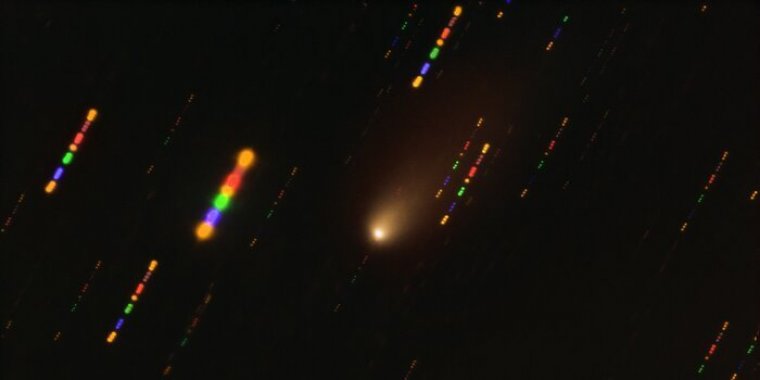| News / Space News |
First interstellar comet may be the most pristine ever found
New observations with the European Southern Observatory’s Very Large Telescope (ESO’s VLT) indicate that the rogue comet 2I/Borisov, which is only the second and most recently detected interstellar visitor to our Solar System, is one of the most pristine ever observed. Astronomers suspect that the comet most likely never passed close to a star, making it an undisturbed relic of the cloud of gas and dust it formed from.

This image was taken with the FORS2 instrument on ESO’s Very Large Telescope in late 2019, when comet 2I/Borisov passed near the Sun. Photo: ESO/O. Hainaut
2I/Borisov was discovered by amateur astronomer Gennady Borisov in August 2019 and was confirmed to have come from beyond the Solar System a few weeks later. “2I/Borisov could represent the first truly pristine comet ever observed,” says Stefano Bagnulo of the Armagh Observatory and Planetarium, Northern Ireland, UK, who led the new study. The team believes that the comet had never passed close to any star before it flew by the Sun in 2019.
Bagnulo and his colleagues used the FORS2 instrument on ESO's VLT, located in northern Chile, to study 2I/Borisov in detail using a technique called polarimetry. Since this technique is regularly used to study comets and other small bodies of our Solar System, this allowed the team to compare the interstellar visitor with our local comets.
The team found that 2I/Borisov has polarimetric properties distinct from those of Solar System comets, with the exception of Hale–Bopp. Comet Hale–Bopp received much public interest in the late 1990s as a result of being easily visible to the naked eye, and also because it was one of the most pristine comets astronomers had ever seen.
Prior to its most recent passage, Hale–Bopp is thought to have passed by our Sun only once and had therefore barely been affected by solar wind and radiation. This means it was pristine, having a composition very similar to that of the cloud of gas and dust it — and the rest of the Solar System — formed from some 4.5 billion years ago.
By analysing the polarisation together with the colour of the comet to gather clues on its composition, the team concluded that 2I/Borisov is in fact even more pristine than Hale–Bopp. This means it carries untarnished signatures of the cloud of gas and dust it formed from.
“The fact that the two comets are remarkably similar suggests that the environment in which 2I/Borisov originated is not so different in composition from the environment in the early Solar System,” says Alberto Cellino, a co-author of the study, from the Astrophysical Observatory of Torino, National Institute for Astrophysics (INAF), Italy.
“The arrival of 2I/Borisov from interstellar space represented the first opportunity to study the composition of a comet from another planetary system and check if the material that comes from this comet is somehow different from our native variety,” explains Ludmilla Kolokolova, of the University of Maryland in the US.
Even without a space mission, astronomers can use Earth’s many telescopes to gain insight into the different properties of rogue comets like 2I/Borisov. “Imagine how lucky we were that a comet from a system light-years away simply took a trip to our doorstep by chance,” says Bin Yang, an astronomer at ESO in Chile, who also took advantage of 2I/Borisov’s passage through our Solar System to study this mysterious comet.
Yang and her team used data from the Atacama Large Millimeter/submillimeter Array (ALMA), in which ESO is a partner, as well as from ESO’s VLT, to study 2I/Borisov’s dust grains to gather clues about the comet’s birth and conditions in its home system.
They discovered that 2I/Borisov’s coma — an envelope of dust surrounding the main body of the comet — contains compact pebbles, grains about one millimetre in size or larger.
In addition, they found that the relative amounts of carbon monoxide and water in the comet changed drastically as it neared the Sun.
The team, which also includes Olivier Hainaut, says this indicates that the comet is made up of materials that formed in different places in its planetary system.
The observations by Yang and her team suggest that matter in 2I/Borisov’s planetary home was mixed from near its star to further out, perhaps because of the existence of giant planets, whose strong gravity stirs material in the system. Astronomers believe that a similar process occurred early in the life of our Solar System. (European Southern Observatory)
YOU MAY ALSO LIKE





